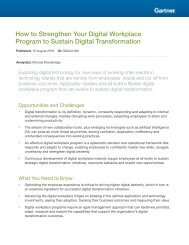The_Future_of_Employment
Create successful ePaper yourself
Turn your PDF publications into a flip-book with our unique Google optimized e-Paper software.
obots can now reproduce some aspects <strong>of</strong> human social interaction, the realtime<br />
recognition <strong>of</strong> natural human emotion remains a challenging problem, and<br />
the ability to respond intelligently to such inputs is even more difficult. Even<br />
simplified versions <strong>of</strong> typical social tasks prove difficult for computers, as is<br />
the case in which social interaction is reduced to pure text. <strong>The</strong> social intelligence<br />
<strong>of</strong> algorithms is partly captured by the Turing test, examining the ability<br />
<strong>of</strong> a machine to communicate indistinguishably from an actual human. Since<br />
1990, the Loebner Prize, an annual Turing test competition, awards prizes to<br />
textual chat programmes that are considered to be the most human-like. In<br />
each competition, a human judge simultaneously holds computer-based textual<br />
interactions with both an algorithm and a human. Based on the responses, the<br />
judge is to distinguish between the two. Sophisticated algorithms have so far<br />
failed to convince judges about their human resemblance. This is largely because<br />
there is much ‘common sense’ information possessed by humans, which<br />
is difficult to articulate, that would need to be provided to algorithms if they are<br />
to function in human social settings.<br />
Whole brain emulation, the scanning, mapping and digitalising <strong>of</strong> a human<br />
brain, is one possible approach to achieving this, but is currently only a<br />
theoretical technology. For brain emulation to become operational, additional<br />
functional understanding is required to recognise what data is relevant, as well<br />
as a roadmap <strong>of</strong> technologies needed to implement it. While such roadmaps exist,<br />
present implementation estimates, under certain assumptions, suggest that<br />
whole brain emulation is unlikely to become operational within the next decade<br />
or two (Sandberg and Bostrom, 2008). When or if they do, however, the employment<br />
impact is likely to be vast (Hanson, 2001).<br />
Hence, in short, while sophisticated algorithms and developments in MR,<br />
building upon with big data, now allow many non-routine tasks to be automated,<br />
occupa tions that involve complex perception and manipulation tasks,<br />
creative intelligence tasks, and social intelligence tasks are unlikely to be substituted<br />
by computer capital over the next decade or two. <strong>The</strong> probability <strong>of</strong> an<br />
occupation being automated can thus be described as a function <strong>of</strong> these task<br />
characteristics. As suggested by Figure I, the low degree <strong>of</strong> social intelligence<br />
required by a dishwasher makes this occupation more susceptible to computerisation<br />
than a public relation specialist, for example. We proceed to examining<br />
the susceptibility <strong>of</strong> jobs to computerisation as a function <strong>of</strong> the above described<br />
27





